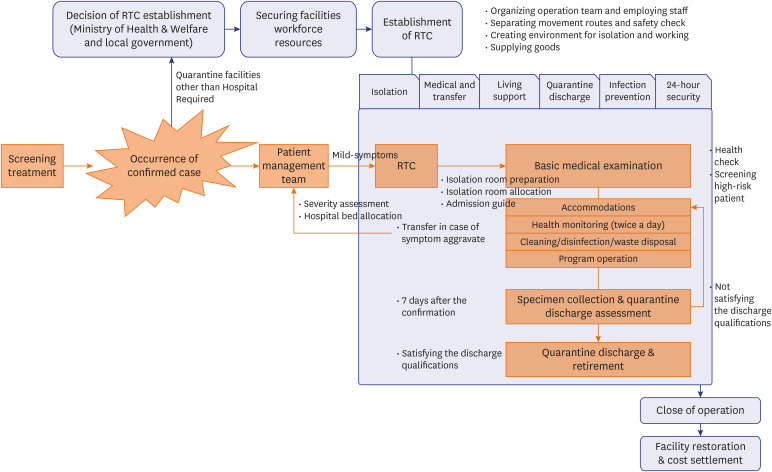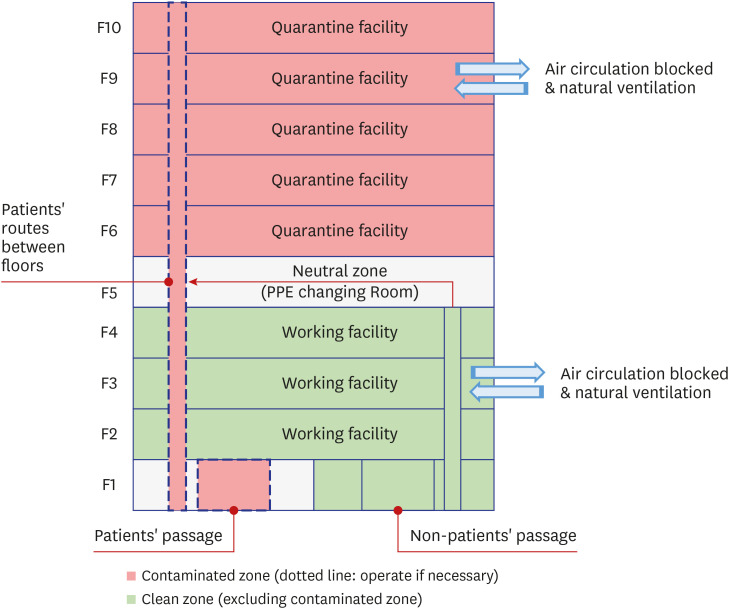J Korean Med Sci.
2020 Dec;35(49):e429. 10.3346/jkms.2020.35.e429.
Quarantine Facility for Patients with COVID-19 with Mild Symptoms in Korea: Experience from Eighteen Residential Treatment Centers
- Affiliations
-
- 1Institute of Health Insurance Research, National Health Insurance Service, Wonju, Korea
- 2Department of Communication and Media, Ewha Womans University, Seoul, Korea
- 3Institute of Health and Environment, Seoul National University, Seoul, Korea
- KMID: 2509598
- DOI: http://doi.org/10.3346/jkms.2020.35.e429
Abstract
- With the rapid spread of coronavirus disease 2019 (COVID-19), a particularly sharp increase in the number of confirmed cases in Daegu and Gyeongbuk regions at the end of February, Korea faced an unprecedented shortage of medical resources, including hospital beds. To cope with this shortage, the government introduced a severity scoring system for patients with COVID-19 and designed a new type of quarantine facility for treating and isolating patients with mild symptoms out of the hospital, namely, the Residential Treatment Center (RTC). A patient with mild symptoms was immediately isolated in the RTC and continuously monitored to detect changes in symptoms. If the symptoms aggravate, the patient was transferred to a hospital. RTCs were designed by creating a quarantine environment in existing lodging facilities capable of accommodating > 100 individuals. The facilities were entirely divided into a clean zone (working area) and contaminated zone (patient zone), separating the space, air, and movement routes, and the staff wore level D personal protective equipment (PPE) in the contaminated zone. The staffs consisted of medical personnel, police officers, soldiers, and operation personnel, and worked in two or three shifts per day. Their duty was mainly to monitor the health conditions of quarantined patients, provide accommodations, and regularly collect specimens to determine if they can be released. For the past two months, RTCs secured approximately 4,000 isolation rooms and treated approximately 3,000 patients with mild symptoms and operated stably without additional spread of the disease in and out of the centers. Based on these experience, we would like to suggest the utilization of RTCs as strategic quarantine facilities in pandemic situations.
Keyword
Figure
Cited by 1 articles
-
The Development and Operation of a Home Management System during the COVID-19 Pandemic: Experience of the Local Government Gyeonggi-do in Korea
Yeji Lee, Jin-Ok Han, Heeyoung Lee, Seungkwan Lim
J Korean Med Sci. 2021;36(19):e134. doi: 10.3346/jkms.2021.36.e134.
Reference
-
1. Kim SW, Lee KS, Kim K, Lee JJ, Kim JY; Daegu Medical Association. A brief telephone severity scoring system and therapeutic living centers solved acute hospital-bed shortage during the COVID-19 outbreak in Daegu, Korea. J Korean Med Sci. 2020; 35(15):e152. PMID: 32301298.
Article2. Ministry of Health and Welfare. A Round-table Conference with Cooperating Hospitals for the COVID-19 RTCs. Sejong: Ministry of Health and Welfare;2020.3. Central Disaster Management Headquarters, Central Disease Control Headquarters. Guidelines for the Operation of COVID-19 Residential Treatment Centers. Sejong: Ministry of Health and Welfare;2020.4. Kang E, Lee SY, Jung H, Kim MS, Cho B, Kim YS. Operating protocols of a community treatment center for isolation of patients with coronavirus disease, South Korea. Emerg Infect Dis. 2020; 26(10):2329–2337. PMID: 32568665.
Article5. Park PG, Kim CH, Heo Y, Kim TS, Park CW, Kim CH. Out-of-hospital cohort treatment of coronavirus disease 2019 patients with mild symptoms in Korea: an experience from a single community treatment center. J Korean Med Sci. 2020; 35(13):e140. PMID: 32242347.
Article6. Choe PG, Kang EK, Lee SY, Oh B, Im D, Lee HY, et al. Selecting coronavirus disease 2019 patients with negligible risk of progression: early experience from non-hospital isolation facility in Korea. Korean J Intern Med. 2020; 35(4):765–770. PMID: 32460457.
Article7. Seoul Health Foundation, Seoul Center for Infectious Diseases Control and Prevention. The Daily News Review. Seoul: Seoul Health Foundation;2020.
- Full Text Links
- Actions
-
Cited
- CITED
-
- Close
- Share
- Similar articles
-
- Types of Perception Toward Quarantine Measures among Patients Infected with COVID-19
- COVID-19 Patients with Mild Symptoms or without Symptom Using Residential Treatment Center Model
- Coronavirus Disease-19: Quarantine Framework for Travelers Entering Korea
- Single center experience of COVID-19 management among kidney transplant recipient in Omicron pandemic
- The Importance of Mandatory COVID-19 Diagnostic Testing Prior to Release from Quarantine




